Stuart Gustafson personally took each photograph displayed, and the images are copyrighted and owned by him. If you click on a thumbnail image, you will see a larger and more complete picture that opens in a separate window.
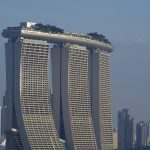
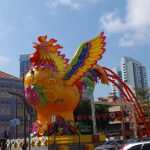 I’ve been to Southeast Asia quite a few times. My first trips there were in 1997 when the high-tech company I worked for would send me to visit the support centers around the world. Recently I’ve been fortunate to speak on cruise ships all over the world, and Singapore is a popular port for beginning and ending these cruise experiences. I’ve been on several that have ported in Singapore; this set of experiences is about an eight-week four-cruise adventure in early 2017. It was late February when my wife and I boarded a plane in San Francisco and flew non-stop to Singapore—a 16.5-hour flight. Arriving two days later in the morning, we checked into the hotel (booked for the previous evening) and then went walking. We were in the Chinatown area so we looked for a place to eat. We found an open market area where competing cobblers were making shoes by hand for their customers; there were no machines involved in the process. Beckoned by several vendors (food vendors not the cobblers), we finally picked one where we ordered a bowl of soup and a rice dish, along with a cold Tiger beer for each of us. It was only 10 AM but our bodies had no idea what time it felt like. We shared our meals—one was a bit spicy and the other was quite plain—and we continued our adventure through the intersecting maze of streets. A keen sense of direction is very helpful here because it would be easy to not know which way was which and you end up going in the wrong direction.
I’ve been to Southeast Asia quite a few times. My first trips there were in 1997 when the high-tech company I worked for would send me to visit the support centers around the world. Recently I’ve been fortunate to speak on cruise ships all over the world, and Singapore is a popular port for beginning and ending these cruise experiences. I’ve been on several that have ported in Singapore; this set of experiences is about an eight-week four-cruise adventure in early 2017. It was late February when my wife and I boarded a plane in San Francisco and flew non-stop to Singapore—a 16.5-hour flight. Arriving two days later in the morning, we checked into the hotel (booked for the previous evening) and then went walking. We were in the Chinatown area so we looked for a place to eat. We found an open market area where competing cobblers were making shoes by hand for their customers; there were no machines involved in the process. Beckoned by several vendors (food vendors not the cobblers), we finally picked one where we ordered a bowl of soup and a rice dish, along with a cold Tiger beer for each of us. It was only 10 AM but our bodies had no idea what time it felt like. We shared our meals—one was a bit spicy and the other was quite plain—and we continued our adventure through the intersecting maze of streets. A keen sense of direction is very helpful here because it would be easy to not know which way was which and you end up going in the wrong direction.
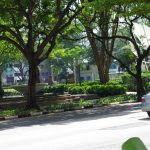
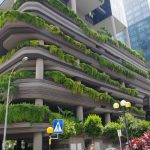 The constant humidity (Singapore is just a little over one degree North of the Equator) and the frequent rainfall keeps the place green and there are plenty of trees that are pruned to resemble an umbrella. The branches open out wide at the top to intercept the incoming sunshine, leaving plenty of space underneath for comforting shade. As you walk along one thing you notice is something that you don’t see—litter. The Singapore people take extreme pride in the cleanliness of their city (Singapore is also the state and the country), plus there are fines if you are caught littering. Besides having amazing food choices, Singapore is also a shopper’s paradise. My wife really likes to wear Crocs™, and we saw a sign outside one of the ever-present shopping malls—you know, the kind where you go in for shopping and then you get lured downstairs to the amazing aromas emanating from the food court! The shoe store was on the main floor, a small corner store, but my wife found a style and color she liked, and so our already packed suitcases just got one more thing to fit in them—and we haven’t even started the cruise yet! We did a lot more walking around while there, strolling along a riverfront area lined with bars and restaurants, and just sitting in a park watching people scurry to work, to appointments, to dates, to shopping. And then came Saturday, time to board the Celebrity MILLENNIUM for the first of our four back-to-back cruises.
The constant humidity (Singapore is just a little over one degree North of the Equator) and the frequent rainfall keeps the place green and there are plenty of trees that are pruned to resemble an umbrella. The branches open out wide at the top to intercept the incoming sunshine, leaving plenty of space underneath for comforting shade. As you walk along one thing you notice is something that you don’t see—litter. The Singapore people take extreme pride in the cleanliness of their city (Singapore is also the state and the country), plus there are fines if you are caught littering. Besides having amazing food choices, Singapore is also a shopper’s paradise. My wife really likes to wear Crocs™, and we saw a sign outside one of the ever-present shopping malls—you know, the kind where you go in for shopping and then you get lured downstairs to the amazing aromas emanating from the food court! The shoe store was on the main floor, a small corner store, but my wife found a style and color she liked, and so our already packed suitcases just got one more thing to fit in them—and we haven’t even started the cruise yet! We did a lot more walking around while there, strolling along a riverfront area lined with bars and restaurants, and just sitting in a park watching people scurry to work, to appointments, to dates, to shopping. And then came Saturday, time to board the Celebrity MILLENNIUM for the first of our four back-to-back cruises.
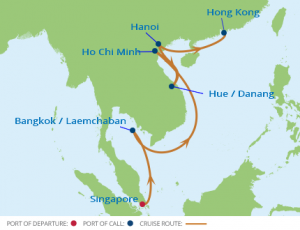
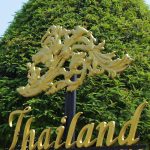
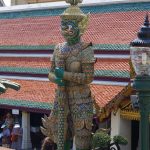 After two full days at sea, our graceful ship entered the Gulf of Thailand and into the port at Laem Chabang. Some of the smaller cruise ships (no more than a few hundred passengers) can actually dock closer to Bangkok, but the majority of the ships dock about a two-hour drive away in Laem Chabang. Sadly, there’s not much to do in the port area, and the “town” itself is a distant walk; so you’re left with taking a tour to Bangkok or to Pattaya—I’ve done both. There are many highlights in Bangkok, with the Grand Palace being the “biggie.” I’ve been there when the motor coach was able to stop close to the main gate. On this latest trip, however, we had to walk about a mile in the searing heat—we were told the reason for not getting close was because their beloved King had died. Why that meant we could drive closer is beyond me; it’s not like our getting near the gate (which we did by walking) was going to make him any more dead. And his body wasn’t there anyway. Oh, well! You do what you have to do. Most tours, especially those from the ship with the two-hour drive each way, don’t spend much time inside the Grand Palace. It’s not that there isn’t much to see—there is. The reason is so you can go see other temples and statues of Buddha. So the best thing is to stay overnight in Bangkok, which has several benefits. You can enjoy some of the Bangkok nightlife and food. You can also get to the Grand Palace when it first opens, thus beating the huge crowds that are there mid-day.
After two full days at sea, our graceful ship entered the Gulf of Thailand and into the port at Laem Chabang. Some of the smaller cruise ships (no more than a few hundred passengers) can actually dock closer to Bangkok, but the majority of the ships dock about a two-hour drive away in Laem Chabang. Sadly, there’s not much to do in the port area, and the “town” itself is a distant walk; so you’re left with taking a tour to Bangkok or to Pattaya—I’ve done both. There are many highlights in Bangkok, with the Grand Palace being the “biggie.” I’ve been there when the motor coach was able to stop close to the main gate. On this latest trip, however, we had to walk about a mile in the searing heat—we were told the reason for not getting close was because their beloved King had died. Why that meant we could drive closer is beyond me; it’s not like our getting near the gate (which we did by walking) was going to make him any more dead. And his body wasn’t there anyway. Oh, well! You do what you have to do. Most tours, especially those from the ship with the two-hour drive each way, don’t spend much time inside the Grand Palace. It’s not that there isn’t much to see—there is. The reason is so you can go see other temples and statues of Buddha. So the best thing is to stay overnight in Bangkok, which has several benefits. You can enjoy some of the Bangkok nightlife and food. You can also get to the Grand Palace when it first opens, thus beating the huge crowds that are there mid-day.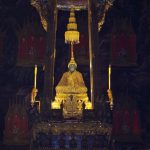
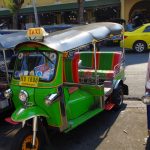 Gold abounds inside the walls of the Grand Palace, and I don’t think it’s possible to look anywhere and not see something made of gold, covered in gold, has gold highlights, etc. Removing our shoes and putting them in a place where we’d remember where they were, we got in line to visit Wat Phra Kaew, the Temple of the Emerald Buddha. Although the statue is only about 28 inches high, it and the temple are regarded as the most sacred Buddhist statue and temple in all of Thailand. As such, only the King and the Crown Prince are allowed to touch the statue and to change out its gold and jeweled garments, which is done three times a year to match the seasons. There is also no photography inside the temple, so I took my photo outside, zooming in the best I could. There wasn’t much more we could see as many of the buildings are closed to tourists, so we went to the Temple of the Reclining Buddha, What Pho. The statue is so long that you can’t get a full picture. Seeing the Mother of Pearl soles of the feet—measuring about fourteen feet long by ten feet high—was truly amazing. Also amazing was our twenty-minute ride in a tuk-tuk. The best advice when riding in one, “Keep your hands inside!” You can see more of the photos I’ve taken in Bangkok on my Bangkok Travel Photos page. There’s also a link on that page to the YouTube video of part of our tuk-tuk ride; it wsa definitely exhilarating!
Gold abounds inside the walls of the Grand Palace, and I don’t think it’s possible to look anywhere and not see something made of gold, covered in gold, has gold highlights, etc. Removing our shoes and putting them in a place where we’d remember where they were, we got in line to visit Wat Phra Kaew, the Temple of the Emerald Buddha. Although the statue is only about 28 inches high, it and the temple are regarded as the most sacred Buddhist statue and temple in all of Thailand. As such, only the King and the Crown Prince are allowed to touch the statue and to change out its gold and jeweled garments, which is done three times a year to match the seasons. There is also no photography inside the temple, so I took my photo outside, zooming in the best I could. There wasn’t much more we could see as many of the buildings are closed to tourists, so we went to the Temple of the Reclining Buddha, What Pho. The statue is so long that you can’t get a full picture. Seeing the Mother of Pearl soles of the feet—measuring about fourteen feet long by ten feet high—was truly amazing. Also amazing was our twenty-minute ride in a tuk-tuk. The best advice when riding in one, “Keep your hands inside!” You can see more of the photos I’ve taken in Bangkok on my Bangkok Travel Photos page. There’s also a link on that page to the YouTube video of part of our tuk-tuk ride; it wsa definitely exhilarating!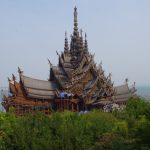
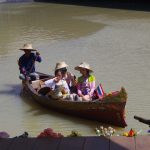 Heading south from Laem Chabang (instead of north to Bangkok), we are able to get to the coastal town of Pattaya in under an hour. You can see many more photos from my visits there on the Pattaya Travel Photos page. The Sanctuary of Truth is clearly the cultural highlight of the area, and it’s fun to see these large motor coaches wind their way through the narrow streets and alleys where there is no room for making them wider. Using no metal fasteners at all, the craftsman continue to add and replace pieces and sections of intricately carved wood for its purpose to use art and culture as “a reflection of the Ancient Vision of Earth, Ancient Knowledge, and Eastern Philosophy.” My late father was a carpenter (I have a carved mahogany table he made in 1960), and I can appreciate the skill it takes to use a hammer and chisel, especially when there are no “do-overs.” The Floating Market in Pattaya is a representation of how societies functioned living along the water. The waterways here, however, are man-made, but it’s still an interesting place to wander around while shopping for souvenirs or a tasty place to eat. I’ve done both in my visits to the Market, and the Tom Yum Soup I had was truly authentic, spicy, and yummy (pardon the pun)!
Heading south from Laem Chabang (instead of north to Bangkok), we are able to get to the coastal town of Pattaya in under an hour. You can see many more photos from my visits there on the Pattaya Travel Photos page. The Sanctuary of Truth is clearly the cultural highlight of the area, and it’s fun to see these large motor coaches wind their way through the narrow streets and alleys where there is no room for making them wider. Using no metal fasteners at all, the craftsman continue to add and replace pieces and sections of intricately carved wood for its purpose to use art and culture as “a reflection of the Ancient Vision of Earth, Ancient Knowledge, and Eastern Philosophy.” My late father was a carpenter (I have a carved mahogany table he made in 1960), and I can appreciate the skill it takes to use a hammer and chisel, especially when there are no “do-overs.” The Floating Market in Pattaya is a representation of how societies functioned living along the water. The waterways here, however, are man-made, but it’s still an interesting place to wander around while shopping for souvenirs or a tasty place to eat. I’ve done both in my visits to the Market, and the Tom Yum Soup I had was truly authentic, spicy, and yummy (pardon the pun)!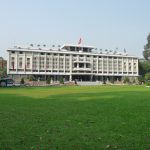
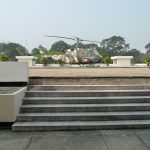 Our two days in Thailand were definitely packed with lots of activity; it was good to have a sea day before reaching our next port—Phu My, Viet Nam. “What’s in Phu My?” you might be thinking right now. The simple answer is, “Not a whole lot.” But it is where we board the coach for the ride into Ho Chi Minh City (HCMC), aka, Saigon (what had been the capital of former South Viet Nam). There are many highlights in HCMC, and I’ve been fortunate to have been there several times; but there’s always more to see. Certainly one of the main features is what is now called the Reunification Hall (photo on left), the former Presidential Palace of South Vietnam until the North Vietnamese tanks came crashing through the main gate on April 30, 1975. Instead of tanks, now it’s motor coaches of tourists who come through that main central gate. The helicopter on the roof do bring back memories for those of us old enough to have experienced the war (it’s called The American War here in Viet Nam). But every time I’ve been in Viet Nam, no matter what city I’m in, I’ve always encountered friendly people, even those from “the North.” You wonder how people who’ve been strafed and bombed and burned can have such a positive outlook; if only everyone could be that positive. Hopefully, that’s one thing thing we can all get out of a cruise—a new outlook on life! Our visit to the Botanical Gardens was highlighted by watching groups of young school children being enthralled by puppets and jugglers. Fun is universal!
Our two days in Thailand were definitely packed with lots of activity; it was good to have a sea day before reaching our next port—Phu My, Viet Nam. “What’s in Phu My?” you might be thinking right now. The simple answer is, “Not a whole lot.” But it is where we board the coach for the ride into Ho Chi Minh City (HCMC), aka, Saigon (what had been the capital of former South Viet Nam). There are many highlights in HCMC, and I’ve been fortunate to have been there several times; but there’s always more to see. Certainly one of the main features is what is now called the Reunification Hall (photo on left), the former Presidential Palace of South Vietnam until the North Vietnamese tanks came crashing through the main gate on April 30, 1975. Instead of tanks, now it’s motor coaches of tourists who come through that main central gate. The helicopter on the roof do bring back memories for those of us old enough to have experienced the war (it’s called The American War here in Viet Nam). But every time I’ve been in Viet Nam, no matter what city I’m in, I’ve always encountered friendly people, even those from “the North.” You wonder how people who’ve been strafed and bombed and burned can have such a positive outlook; if only everyone could be that positive. Hopefully, that’s one thing thing we can all get out of a cruise—a new outlook on life! Our visit to the Botanical Gardens was highlighted by watching groups of young school children being enthralled by puppets and jugglers. Fun is universal!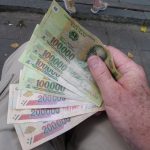
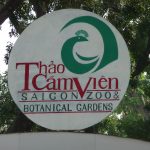
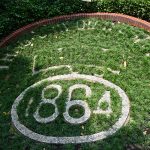
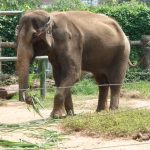
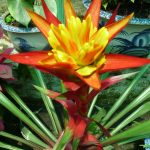
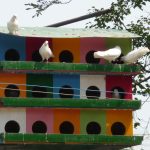
For those cruise ship passengers who want “to feel extra rich,” this is the place because you can become a Millionaire for a little under $50 USD. At an exchange rate of over 22,000 to 1, it doesn’t take much moolah to be holding ONE MILLION Dong in your hand. Ooh-lah-lah! [Here’s a Pro Travel Tip: Unless you’re going on a completely self-contained tour, you will want to have some local currency for tips, minor shopping, and bargaining—I’ve always gotten a better deal when I’ve had the local currency in my hand, specially in SE Asia.]
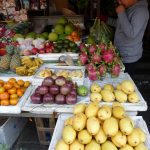
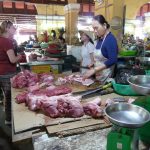
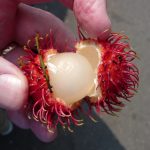
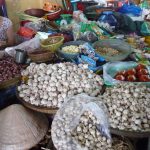 After our much-too-short visit to Ho Chi Minh City, the ship reversed course and headed South to the port of Chan May, which juts out into the China Sea. I’d been there before, or at least our ship attempted to dock there before, but stormy weather kept us away. We made it this time, and we had so many good choices of places to visit—Danag, Hue, or Hoi An. We chose to go to Hoi An and enjoy a cooking demonstration. Our tour began with a stroll through this old village that has maintained much of its small-town charm despite being a very popular tourist destination. Our journey through the Village market included sampling some of the local fruits, seeing how the meats are cut, and then we had some time at one stall where the vendor showed us several types of garlic and onions.
After our much-too-short visit to Ho Chi Minh City, the ship reversed course and headed South to the port of Chan May, which juts out into the China Sea. I’d been there before, or at least our ship attempted to dock there before, but stormy weather kept us away. We made it this time, and we had so many good choices of places to visit—Danag, Hue, or Hoi An. We chose to go to Hoi An and enjoy a cooking demonstration. Our tour began with a stroll through this old village that has maintained much of its small-town charm despite being a very popular tourist destination. Our journey through the Village market included sampling some of the local fruits, seeing how the meats are cut, and then we had some time at one stall where the vendor showed us several types of garlic and onions.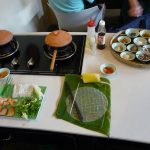
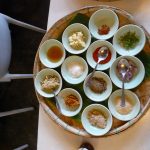
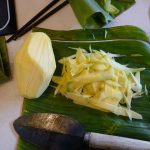
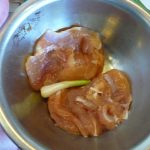 Vy’s Market and Restaurant was the site for our cooking demonstration, and the upstairs set-up made it quite clear that they do a lot of these classes. The organization was excellent, and ti was fun to hear how to properly prepare the local dishes. As you see, there were lots of spices to add, and we learned how to use a new type of grater; we even received one as a gift (along with the recipes of our dishes). As we were getting back on the ship, these graters set off the security alarm; fortunately we were all there together, and it was an easy explanation—nothing like going through a TSA screening at the airports.
Vy’s Market and Restaurant was the site for our cooking demonstration, and the upstairs set-up made it quite clear that they do a lot of these classes. The organization was excellent, and ti was fun to hear how to properly prepare the local dishes. As you see, there were lots of spices to add, and we learned how to use a new type of grater; we even received one as a gift (along with the recipes of our dishes). As we were getting back on the ship, these graters set off the security alarm; fortunately we were all there together, and it was an easy explanation—nothing like going through a TSA screening at the airports.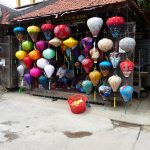
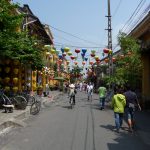
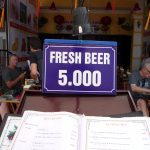
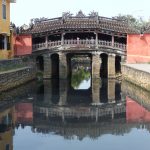
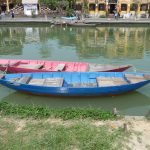 We used our free time after the cooking class to walk around the town, find the Post Office and mail some postcards, and then try a local beer. I had never heard of “Fresh Beer,” but it seemed like a bargain at only 5,000 Dong—the equivalent of about 22 U.S. cents. Well, it’s not worth even that much. Weak in flavor and alcohol, one glass of this bargain beer was more than enough. The river was interesting; not only was it a way for the fishing boats to get out to sea, it was also a nice place for walking and sitting and just enjoying the day. It seemed that most of the hotels were on ones side, and the restaurants and bars were on the other. We were tempted to purchase one of the hand-made paper lanterns, but we didn’t think it would survive the remaining 6+ weeks of our cruising and the trip home. They were pretty to see, but looking back on the opportunity, I don’t know where we would put it in our house! We made a good choice to not buy one.
We used our free time after the cooking class to walk around the town, find the Post Office and mail some postcards, and then try a local beer. I had never heard of “Fresh Beer,” but it seemed like a bargain at only 5,000 Dong—the equivalent of about 22 U.S. cents. Well, it’s not worth even that much. Weak in flavor and alcohol, one glass of this bargain beer was more than enough. The river was interesting; not only was it a way for the fishing boats to get out to sea, it was also a nice place for walking and sitting and just enjoying the day. It seemed that most of the hotels were on ones side, and the restaurants and bars were on the other. We were tempted to purchase one of the hand-made paper lanterns, but we didn’t think it would survive the remaining 6+ weeks of our cruising and the trip home. They were pretty to see, but looking back on the opportunity, I don’t know where we would put it in our house! We made a good choice to not buy one.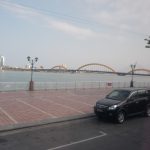
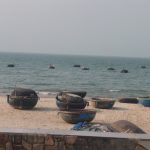
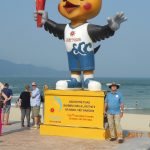 Our bus made a stop at China Beach in Da Nang on our way back to the ship. This was quite the popular R&R spot for U.S. service personnel during the Vietnam War. The beach area wasn’t very crowded as it was a late Monday afternoon when we were there. We did see many fishing vessels ashore, ready to head back out with their owners the next morning. We crossed over the famous Dragon Bridge over the River Hàn at Da Nang; I wish we’d stopped so I could have gotten some better pictures of it. Take a look at this photo from Wikipedia. As was the case in Ho Chi Minh City, the people here and in Hoi An were very polite and happy people. I can see why so many tourists flock to Hoi An and stay for several weeks; that might become a future vacation spot for me!
Our bus made a stop at China Beach in Da Nang on our way back to the ship. This was quite the popular R&R spot for U.S. service personnel during the Vietnam War. The beach area wasn’t very crowded as it was a late Monday afternoon when we were there. We did see many fishing vessels ashore, ready to head back out with their owners the next morning. We crossed over the famous Dragon Bridge over the River Hàn at Da Nang; I wish we’d stopped so I could have gotten some better pictures of it. Take a look at this photo from Wikipedia. As was the case in Ho Chi Minh City, the people here and in Hoi An were very polite and happy people. I can see why so many tourists flock to Hoi An and stay for several weeks; that might become a future vacation spot for me!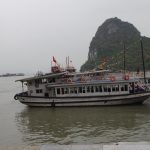
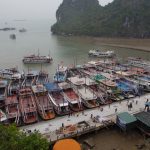
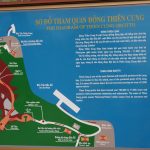
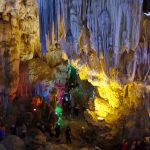
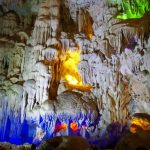
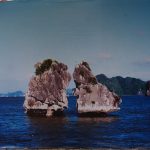
The stunning port of Ha Long Bay was our next stop, and it included an overnight stay while we were anchored. This is the jumping off point for those wishing to go to Ha Noi (Hanoi), and since it’s a three-hour trip in to the capital city, most people stay overnight once they’re there. The boats out to the famous limestone caves pull right up to the anchored ship, and we boarded ours for the short ride out to the island. There are about 2,000 islands in the bay, and only about 40 of them are inhabited. The main highlight is the group of limestone caves that have been turned into tourist attractions. You can tell by the number of boats that were there with us that this is quite a popular place, and not just for the cruise ship passengers.If you look at the back of a 200,000 Viet Dong note, you will see the Kissing Rocks; they are cemented into the history of Viet Nam!
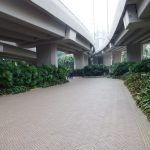
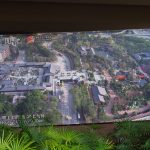
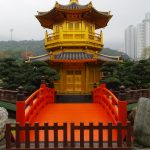
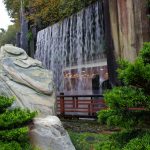 After our final day at sea, we pulled into the majestic port of Hong Kong, a Special Administrative Region (SAR) of the People’s Republic of China. What the SAR designation means is that Hong Kong may have its own currency, laws, rules and regulations, but still is under the primary jurisdiction of Beijing. Although it’s been more than twenty years since Hong Kong was handed back to China from Great Britain, much of the British influences is still evident. Our first visit was to the Nan Lian Garden that sits underneath a few freeway overpasses. Even though you are right in town, the noises of the city are not so prevalent as you stroll along the pathways of the rocks and the sculpted trees. The use of water and waterfalls also helps to create a nice ambience.
After our final day at sea, we pulled into the majestic port of Hong Kong, a Special Administrative Region (SAR) of the People’s Republic of China. What the SAR designation means is that Hong Kong may have its own currency, laws, rules and regulations, but still is under the primary jurisdiction of Beijing. Although it’s been more than twenty years since Hong Kong was handed back to China from Great Britain, much of the British influences is still evident. Our first visit was to the Nan Lian Garden that sits underneath a few freeway overpasses. Even though you are right in town, the noises of the city are not so prevalent as you stroll along the pathways of the rocks and the sculpted trees. The use of water and waterfalls also helps to create a nice ambience. 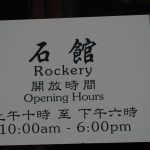
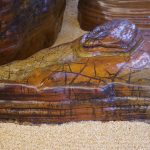
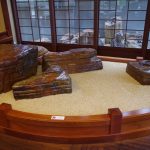
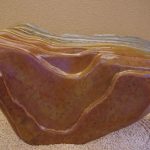 I consider myself a rather knowledgeable traveler . . . . but I had never heard of a “Rockery.” Have you? We saw the sign for one in the Garden, and we had to check it out. Just as the name suggests, a Rockery is a place, a garden if you wish, that highlights rocks. Okay. This particular Rockery had some pretty amazing specimens, some of them dating from hundreds of millions of years ago. That’s old! The curator apparently also has a sense of humor. Over one display of a beautiful rock setting in sand was a calligraphy banner, and then a translation below it: “Fine rocks are good-looking.” Yes, indeed; they are. Being indoors in the Rockery also gave us a little respite from the gentle rain that was coming down. We could have used our umbrella, but it was also nice to just be dry and enjoy a new experience that we’d never had before.
I consider myself a rather knowledgeable traveler . . . . but I had never heard of a “Rockery.” Have you? We saw the sign for one in the Garden, and we had to check it out. Just as the name suggests, a Rockery is a place, a garden if you wish, that highlights rocks. Okay. This particular Rockery had some pretty amazing specimens, some of them dating from hundreds of millions of years ago. That’s old! The curator apparently also has a sense of humor. Over one display of a beautiful rock setting in sand was a calligraphy banner, and then a translation below it: “Fine rocks are good-looking.” Yes, indeed; they are. Being indoors in the Rockery also gave us a little respite from the gentle rain that was coming down. We could have used our umbrella, but it was also nice to just be dry and enjoy a new experience that we’d never had before.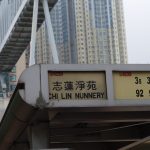
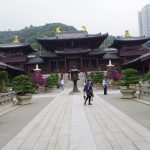
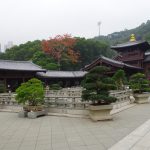
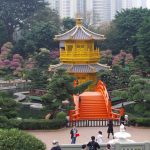 A modern roadway now separates the Garden from the Chi Lin Nunnery, so we took the overhead walkway after we left the Rockery. The Lotus Pond area greeted us with water treatments of different shapes, texture, and quiet places for respite from the outside noises. Many of the trees were shaped like the ones in Nan Lian Garden, although most of these were in pots rather than being planted directly in the ground. While this was an interesting place to wander around, I was slightly disappointed that we weren’t able to visit or view any of the actual nunnery rooms.
A modern roadway now separates the Garden from the Chi Lin Nunnery, so we took the overhead walkway after we left the Rockery. The Lotus Pond area greeted us with water treatments of different shapes, texture, and quiet places for respite from the outside noises. Many of the trees were shaped like the ones in Nan Lian Garden, although most of these were in pots rather than being planted directly in the ground. While this was an interesting place to wander around, I was slightly disappointed that we weren’t able to visit or view any of the actual nunnery rooms.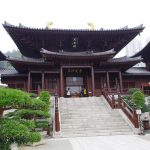
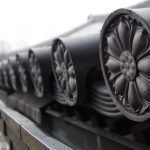
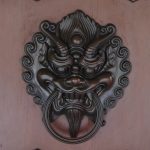
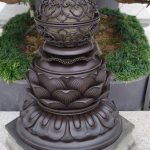 Perhaps that was good because I was then able to focus on designs and patterns, hoping the camera shots would accurately capture what my eyes were seeing. The sloping roofs appear to be constructed from the same metallic materials as the door decorations, the lotus candles, and all the other paraphernalia on the walls and buildings. Even though we weren’t allowed inside any of the private rooms, there were some areas where we were allowed to step inside and see where they prayed. The incense smell was quite strong, and the music that we heard and initially thought it was live chanting turned out to be from a recorded CD that was for sale in the ground-level gift shop.
Perhaps that was good because I was then able to focus on designs and patterns, hoping the camera shots would accurately capture what my eyes were seeing. The sloping roofs appear to be constructed from the same metallic materials as the door decorations, the lotus candles, and all the other paraphernalia on the walls and buildings. Even though we weren’t allowed inside any of the private rooms, there were some areas where we were allowed to step inside and see where they prayed. The incense smell was quite strong, and the music that we heard and initially thought it was live chanting turned out to be from a recorded CD that was for sale in the ground-level gift shop.Our first cruise ended here in Hong Kong, and we waited for the next group of passengers to arrive, and we pulled out of port that evening.
Return to FEATURED Experiences
Note: This was a SPONSORED trip meaning that the cruise line covered the majority of my expenses on these cruises in return for my giving presentations during the cruises. There was no anticipation or expectation of my writing a review. Regardless, the review is purely my subjective view of the service and perceived value received had I been paying for it in full myself. I am disclosing this in accordance with the Federal Trade Commission’s 16 CFR, Part 255: “Guides Concerning the Use of Endorsements and Testimonials in Advertising.”
Privacy Policy — Site Terms — Media Kit